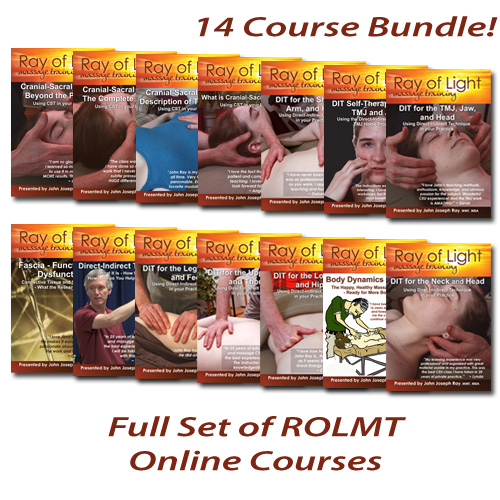“John is just one of the best Continuing Ed teachers I’ve had in a very long time…I love the way that John combines the indirect and the direct techniques…That is just a revolutionary approach.” – Valerie
Direct-Indirect Technique™ (DIT)
What it is – How it Helps You Help Your Client
Direct-Indirect Technique™ (DIT) is a highly successful modality that combines effective myo-fascial, neuro-muscular, and cranial-sacral techniques into one cohesive toolbox of client-tested techniques that really work!
With DIT, you learn to use both deep ‘direct’ and gentle ‘indirect’ techniques to: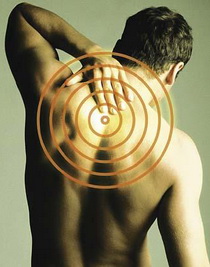
- Release tight muscles and interconnected fascia
- Lengthen restricted muscle fibers and fascial tissue
- Work as deep or light as you need to for each client
- Help clients experience long-lasting relief, better range of motion, and a better quality of life!
You will learn how to use both direct and indirect techniques in a systematic way to give your clients the immediate and long-term relief they need. You will see which techniques work best with different conditions and client types.
I’ve tested these techniques with many years of experience and more than 12,000 bodywork sessions. Along the way, I’ve successfully treated people with many painful conditions, including sciatica, fibromyalgia, migraines, knee problems, and much more.
This is not rocket science. You can do this, too! I’ve successfully taught these techniques to many therapists who quickly see that when their clients feel better, they are able to continue doing the activities they enjoy, and they tend to refer many more clients. Everyone benefits!
“Excellent experience. John has a natural talent for teaching in a way that is immediately understandable and inspiring.” ~ Quinn
DIT for Treating Upper Back Pain and Related Conditions
In this class, you will learn real tools for the upper back that you can use right away in your practice, maximizing the effectiveness of your massage technique while minimizing stress on your body. There is hardly a person on the planet that does not have upper or mid back pain and soreness at some point in their lives. We find people with extraordinarily tight muscles and fascia in this region every day!
 With this class, you will practice a specific combination of myofascial, neuromuscular, deep tissue, and cranial-sacral techniques for relieving tight upper back muscles and fascia – a blend of deep and gentle techniques that are very effective when used together.
With this class, you will practice a specific combination of myofascial, neuromuscular, deep tissue, and cranial-sacral techniques for relieving tight upper back muscles and fascia – a blend of deep and gentle techniques that are very effective when used together.
We will explore the muscle and fascial anatomy of the upper back, as well as common compensation patterns and trigger point referral patterns, and demonstrate how these can be relieved using these techniques.
Areas of focus include techniques for the rhomboids, mid & lower trapezius, erector spinae, deep rotators & multifidi, and other spinal muscles, serratus muscles, as well as the pectoral muscles, which often counterbalance upper back tightness.
So many things that we do these days encourage poor postural patterns. Our occupations, our activities, even our furniture often lead to back problems. We tune out all the soreness for awhile, until the time comes when we can’t ignore it any longer. These DIT techniques are very effective at relieving clients’ sore backs, so that they feel better longer and are able to comfortably continue their jobs and activities.
The DIT-Upper-Back class can be taken on its own or combined with DIT-Legs and DIT-Low-Back for even greater results.
“In 25 years of education workshops and massage CEU classes this is the best experience I’ve ever had. The instructor is extremely knowledgeable.” ~ Linda
DIT to Effectively Relieve Low Back Pain
This class will focus on specific Direct and Indirect Techniques to relieve low back issues. You will learn how to use the DIT techniques to treat Low Back pain, hip and pelvis soreness, tight Quadratus Lumborum, medial rotators (Gluteus Medius, Minimus, and TFL), lateral rotators (Piriformis and the rest of the Deep 6), and the IlioPsoas muscles. You will identify and treat muscle and fascial compensation patterns – what pattern is presenting, and what’s the best technique to use.
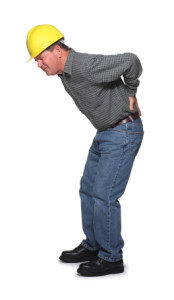 Many clients with herniated discs, sciatica, and other low back and hip problems have benefited from these techniques. Nearly all experience profound relief. Some have been able to avoid more invasive treatments, including surgery, and return to the activities and work they love.
Many clients with herniated discs, sciatica, and other low back and hip problems have benefited from these techniques. Nearly all experience profound relief. Some have been able to avoid more invasive treatments, including surgery, and return to the activities and work they love.
In this class, you will learn real tools for the low back that you can use right away in your practice to maximize the effectiveness of your work while minimizing stress on your body. DIT for low back combines effective myofascial, neuromuscular, and cranial-sacral techniques to relieve tight muscles and fascia. You will learn both deep and gentle DIT techniques that work very well together.
In addition, we will explore the muscle and fascial anatomy of the low back, common compensation patterns, and trigger point referral patterns, demonstrating how these can be relieved using DIT techniques.
“If you have not taken one of John Ray’s CEU’s then you are missing out. Excellent instructor and lots of great techniques. I took DIT for legs, hips, and back, and I absolutely LOVED the class. I have used it in every massage since.” ~ Crystal
The DIT-Low Back class can be taken on its own or combined with DIT-Legs and DIT-Upper Back for even greater results.
DIT for Treating Leg, Knee, & Foot Pain
Hands-On Soft Tissue Mobilization Techniques
Direct-Indirect Technique™ for the Legs, Knees, and Feet is a powerful therapeutic modality that facilitates the release of painful muscular and fascial restrictions that develop over time due to injuries, poor posture, repetitive movement patterns, and stress.
 In this class, you will learn real tools for the legs, knees and feet that you can use right away in your practice, maximizing the effectiveness of your massage technique while minimizing stress on your body.
In this class, you will learn real tools for the legs, knees and feet that you can use right away in your practice, maximizing the effectiveness of your massage technique while minimizing stress on your body.
We will focus on the Leg and Foot muscles, including the Quadriceps, Hamstrings, the TFL and IT Band, Gastrocnemius/Soleus, Anterior & Posterior Tibialis, as well as other muscles, tendons, and fascial structures. You will also learn how to relieve knee pain, plantar fascitis, and more.
You will practice a specific combination of myofascial, neuromuscular, deep tissue, and cranial-sacral techniques for relieving tight leg, knee and foot muscles and fascia – a blend of deep and gentle techniques that are very effective when used together.
We will explore the muscle and fascial anatomy of the legs, knees and feet, as well as common compensation patterns and trigger point referral patterns, and demonstrate how these can be relieved using these techniques. We will look at which leg, knee and feet conditions can benefit from the use of these techniques and which conditions are contraindicated.
Since several leg muscles attach to the pelvic bones, tightness or weakness in these muscles and tendons is often involved in low back pain patterns. Thus, it’s highly beneficial to take the DIT-Legs class along with the DIT-Low Back and Upper Back classes.
“This was my third set of CEUs with John and his are easily the best CEUs I’ve taken. When I leave his CEUs I am able to immediately incorporate what I’ve learned into client body work. His presentation and professional presence help make his classes fun as well as instructive.” ~ Sidney
DIT for Treating Shoulder, Arm, and Hand Conditions
Many activities and occupations cause people to have problems with their shoulder, arm, elbow, wrist, or hand. We see athletes with shoulder pain, musicians with hand pain, massage therapists with forearm or thumb pain, construction workers with chronic elbow soreness, office workers with wrist issues, and much more.

Topless athletic man holds elbow as he shrieks in pain
These clients usually do not have the luxury to just stop the activities and jobs that produce their repetitive movement patterns. With DIT, you can relieve their discomfort and pain and help them find ways to continue the work and activities they love.
You will learn Direct and Indirect Techniques for the rotator cuff muscles (infraspinatus, supraspinatus, teres minor, and subscapularis), deltoids and upper arm muscles (biceps, brachialis, coracobrachialis, and triceps), forearm muscles (brachioradialis, supinator, pronators, flexors, and extensors), and muscles of the hand.
You will use a specific combination of both deep and gentle myofascial, neuromuscular, and cranial-sacral techniques that effectively relieve tight shoulder, arm and hand muscles and fascia. You will also practice DITechniques to address brachial plexus difficulties resulting in shooting pain, numbness, or tingling down the arm and/or into the wrist and hand.
We will explore the muscle and fascial anatomy of the shoulder, arm and hand, as well as common compensation patterns and trigger point referral patterns, and demonstrate how these can be relieved using these techniques. In this class, you’ll learn real tools for the shoulder, arm and hand that you can use right away in your practice, maximizing the effectiveness of your work while minimizing stress on your body.
“I thought I knew it all when working on neck and shoulders, but I was wrong. Mr. Ray, you were wonderful. I will be able to help a lot of people with what I learned. Thank you so much.” ~ Kevin
The DIT for Shoulder class combines well with the DIT for Neck and DIT for TMJ classes.
DIT for Treating Neck Pain, Hypertonicity, & Related Conditions
Millions of people carry tremendous tension in their neck – including a lot of massage therapists! With DIT, therapists have the tools they need to work effectively on a variety of neck conditions. For many of our students, this comment from satisfied clients is common: ‘No one has ever worked on my neck like that before.’

woman with severe neck pain, rubbing her neck with her hand
This class will give you the tools you need to help your clients feel as if their neck is brand new. You will learn real tools that you can use right away in your practice, maximizing the effectiveness of your massage technique while minimizing stress on your body.
The areas of focus include the major anterior neck muscles (SCM, scalenes, hyoids, etc.) and posterior neck muscles (levator scapula, upper trapezius, suboccipitals, splenius, superior erector spinae and transversopinalis group), as well as other supporting muscles and structures.
You will practice a specific combination of myo-fascial, neuro-muscular, and cranial-sacral techniques for relieving tight neck muscles and fascia – a blend of deep and gentle techniques that are very effective when used together.
We will explore the muscle and fascial anatomy of the neck, as well as common compensation patterns and trigger point referral patterns, and demonstrate how these can be relieved using the DIT techniques.
“I can say without a doubt that taking your classes has made a huge difference in my work, business and most of all for my clients! Receiving that bodywork helped my neck issues and has made it possible for me to continue doing what I love,massage!! Thank you for sharing your knowledge and expertise!!” (Lori)
This DIT for the Neck class combines well with the DIT for the Shoulder and Arm and DIT for TMJ classes.
DIT for TMJ Dysfunction, Jaw Pain, and Related Conditions
TMJ Dysfunction affects more people than most therapists would expect. The jaw clenchers and teeth-grinders of the world are numerous, and you may even be one of them! TMJD is often involved with Neck pain, and it can also be a major factor with headaches, including migraines!

Woman with head pains
Many people with TMJD do not realize that their jaw muscles are a source of their symptoms. And if they do, they do not know that their symptoms can often be treated successfully with specific massage techniques! In this class, you will learn real tools for the TMJ that you can use right away in your practice to give your clients relief.
The primary learning objectives of this course are to help massage therapists recognize the different causes of TMJD and Jaw pain, what symptoms indicate possible TMJD, and how to use Direct-Indirect Technique™ to treat TMJD, Jaw pain, and related conditions.
You will practice a specific combination of myofascial, neuromuscular, deep tissue, and cranial-sacral techniques for relieving tight TMJ muscles and fascia – a blend of deep and gentle techniques that are very effective when used together.
We will explore the muscle and fascial anatomy of the TMJ, as well as common compensation patterns and trigger point referral patterns, and demonstrate how these can be relieved using these techniques.
“I love John’s teaching methods, enthusiasm, knowledge, and obvious passion for the subject. Wonderful CEU experience! And the TMJ work is AMAZING!” ~ Sarah
The DIT for TMJ class combines well with the DIT for Neck and DIT for Shoulder classes.
Self-Therapy for the TMJ and Jaw
TMJ Dysfunction affects more people than most therapists would expect. The jaw clenchers and teeth-grinders of the world are numerous, and you may even be one of them! In addition, TMJD is often involved with Neck pain, and it can be a major factor in headaches, including migraines!

Woman with head pains
Many people with TMJD do not realize that their jaw muscles are the source of their symptoms. And if they do, they don’t know that their symptoms can often be treated successfully with effective massage techniques. In between DIT for TMJ and Neck sessions, clients can help themselves maintain relief and keep the Jaw structures from excess tightening and stressing.
The focus of this class is to provide a TMJD home program that you can use for yourself and teach your clients to do for themselves between massage sessions. Relieving chronically tight jaw muscles a little bit every day helps to reprogram them to a more relaxed ‘normal’. Clients receive dramatic relief from the therapist, they can help maintain that relief, and they refer lots of other people to get similar relief from chronic pain. It’s a win-win!
TMJ Self-Therapy helps you and your clients to build more body awareness, so that you know when you’re clenching your jaw. Doing the home program at night before bed also helps lessen the tendency toward clenching and teeth grinding while sleeping. The result is that you feel more refreshed when you wake up. And the tendency toward headaches is lessened or eliminated, too.
In this class, you will learn a specific combination of myofascial, neuromuscular, and cranial-sacral techniques for relieving tight TMJ and Jaw muscles and fascia – a blend of deep and gentle techniques that are very effective when used together.
“The instructions were easy to follow and interesting. I have had 2 previous TMJ workshops, but this was the best and most beneficial.” ~ Brenda
CST1 – What is Cranial-Sacral Therapy?
Introduction and Essential Tools
This class shows you how Cranial-Sacral Therapy (CST) works. CST is a gentle therapeutic technique that can be used successfully on a wide variety of clients, including many who would ordinarily be contraindicated for massage.
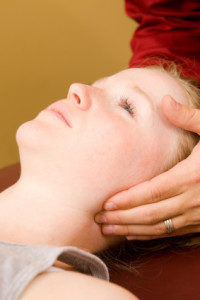 With CST, you release restrictions in the bones and fascial tissue in the cranium and along the spine, as well as other parts of the body, to allow a free flow of cerebrospinal fluid. This encourages healthier function in the central nervous system (CNS) and throughout the entire body. As you may know, the CNS is like Mom – when the CNS is happy, everything is happy!
With CST, you release restrictions in the bones and fascial tissue in the cranium and along the spine, as well as other parts of the body, to allow a free flow of cerebrospinal fluid. This encourages healthier function in the central nervous system (CNS) and throughout the entire body. As you may know, the CNS is like Mom – when the CNS is happy, everything is happy!
In this course, you’ll understand the anatomy and physiology of the Cranial-Sacral system and how CST helps it to function optimally. You’ll learn how CST originated and how it’s different from other modalities, when therapists use CST in their practice, what conditions respond well to CST techniques, and what conditions would be contraindicated.
You’ll find that you can use CST in different ways to help your clients. You can combine your good bodywork techniques with CST, or you can do a complete CST session. As you use CST with your clients, you notice that they leave feeling like they received much more than a good massage. And you also notice that it’s a lot easier on your body.
In the live class, you learn and practice some of the essential tools of Cranial-Sacral Therapy. It’s highly beneficial to take this CST1 class together with CST2 (Advanced Tools) and CST3 (Complete Protocol).
“I use these techniques on many of my clients and they have had amazing results!! You can’t go wrong taking a class from John.” ~ Lori
CST2 – Advanced Tools & Techniques
Cranial-Sacral Therapy – Description of Techniques
This class guides you to easily understand and use essential and advanced Cranial-Sacral Therapy (CST) tools to enhance your therapeutic practice and meet your clients’ unique needs.
 You will learn gentle CST techniques that enable you to work on clients with many different conditions. These techniques have been used successfully on clients with tension headaches, migraines, back pain, neck pain, fibromyalgia, and many conditions where lighter work is more appropriate than regular massage.
You will learn gentle CST techniques that enable you to work on clients with many different conditions. These techniques have been used successfully on clients with tension headaches, migraines, back pain, neck pain, fibromyalgia, and many conditions where lighter work is more appropriate than regular massage.
Several CST techniques are very helpful with kids (or adults) with ADD or ADHD, clients with autoimmune diseases, clients that prefer to stay clothed for whatever reason, cancer patients, hospice patients, and many others.
You’ll also learn how to facilitate a deep relaxation and reorganization of the Cranial-Sacral system, which has a powerful calming effect on the central Nervous System.
The class includes excellent instruction and demonstration of several advanced CST techniques that beneficially affect the cranial bones, underlying dural tissue structures, and the flow of the cerebro-spinal fluid. In the live class, you will have ample time to practice these techniques.
Prerequisite: CST1 or similar class approved by the instructor. It’s highly beneficial to take this CST2 class together with CST1 (Intro & Essential Tools) and CST3 (Complete Protocol).
“This class was ‘life changing’…These techniques can change your practice and the lives of your clients in such a positive way. Take this course – it’s a must!” ~ Tom
CST3 – Complete Multi-Step Protocol
How to Do a Full Cranial-Sacral Therapy Session
This class enables the licensed massage therapist that is familiar with CST techniques (such as in CST1 and CST2) to learn and perform a fluid, multi-step Cranial-Sacral Therapy protocol within a self-contained client session.
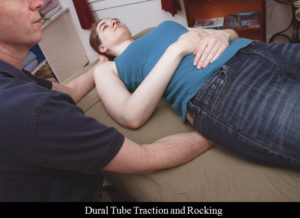 As part of this experience, you will learn which CST techniques are best for specific conditions and different types of clients. You will also learn how to modify the complete CST protocol to address specific client needs.
As part of this experience, you will learn which CST techniques are best for specific conditions and different types of clients. You will also learn how to modify the complete CST protocol to address specific client needs.
In the live class, each participant will recieve a full CST session. This helps you to understand some of experiences that clients might have on the table, since we will discuss what was experienced by both therapists and clients during the sessions. In the home study class, you will see a demonstration of a full protocol CST session.
Prerequisite: CST1 and CST2 or similar CST training approved by the instructor. It’s highly beneficial to take this CST3 class together with CST1 (Introduction and Essential Tools) and CST2 (Advanced Tools).
“John is one of my favorite instructors, always breaking things down into plain English, but also getting the message across in a way that still gives that deep understanding. I loved the course.” ~ Stephanie
CST4 – Beyond the Protocol
Expanding Your Experience of Cranial-Sacral Therapy
This course is for students who have already had some training in Cranial-Sacral Therapy and want to deepen their understanding of and confidence in how to use CST in their practice.
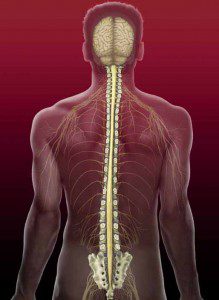 Students will expand their understanding of how and when to do a complete CST session. You will also learn how to mix and match CST techniques with other bodywork techniques and styles in a way that maximizes the benefit to the client with regard to the specific condition they have.
Students will expand their understanding of how and when to do a complete CST session. You will also learn how to mix and match CST techniques with other bodywork techniques and styles in a way that maximizes the benefit to the client with regard to the specific condition they have.
A description of some of the various specialties and advanced techniques within CST is offered as a way to show students how they can continue their training in CST and their ability to use the techniques optimally.
The course will also outline how to work with specific populations, such as infants and children, clients with fibromyalgia, clients that have an emotional release during the massage session, and clients who are elderly, bed-bound, or in hospice. The live class will include some practice sessions to better comprehend how to work with these populations.
Prerequisite: CST1, CST2, and CST3 or similar CST training is recommended prior to taking this class.
“I love the class and enjoyed learning a technique that is easy on my body. I also learned that it’s ok to not be perfect and that I can learn at my own pace.” ~ Sarah
Fascia – Function and Dysfunction
Connective Tissue and So Much More – What the Research Says
This course focuses on Fascia – the connective tissue that permeates every part of the human body. We will look at the types of fascia, the composition of fascia, the characteristics of fascia, and what are the many important tasks that fascia does in the body.

From Strolling Under the Skin – with the kind permission of Dr J.C. GUIMBERTEAU and Endovivo Productions
We will look at the problems that can occur in the body when there are fascial restrictions – adhesions, inflammation, scarring, neurological issues, compensations, etc. Much of the content for this course comes from the recent international fascial congresses, where fascia researchers from around the world have come together to share their research on fascia. As part of this recent research, we now know that fascia is involved with many more bodily processes than was ever suspected in the past.
We will also look at how fascia has been described and treated historically and how the perspective on this connective tissue is changing drastically in recent years, although old perceptions of fascia still exist in some areas.
“BOY WHAT A GREAT CLASS YOU TAUGHT! Thank you so much.” ~ Tanya
Direct-Indirect Body Dynamics Mastery
Keeping the Therapist Healthy, Happy, and Ready for More Bodywork
In this class, you will learn practical tools you can use to maximize the success of your massage technique while minimizing stress on your body. This will allow you to keep doing the work you love for many years to come, while continuing to offer high-quality massages to your clients, and getting the most out of your investment in massage school and beyond.
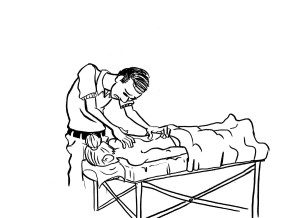 You will practice specific, fun techniques to protect your thumbs, wrists, elbows, shoulders, neck, back, hips, and legs during massage work. You will accomplish this while increasing your body awareness, moving more freely, and minimizing tension, leading to more effective sessions and happier clients.
You will practice specific, fun techniques to protect your thumbs, wrists, elbows, shoulders, neck, back, hips, and legs during massage work. You will accomplish this while increasing your body awareness, moving more freely, and minimizing tension, leading to more effective sessions and happier clients.
We will look at the anatomy of specific joints, muscles, and other structures as they relate to massage work, especially with regard to repetitive movement, overuse of certain muscles, and tension. You will learn effective ways to stay in touch with your client’s needs and give an excellent massage, while protecting your body and your livelihood.
Direct-Indirect Body Dynamics helps you become more aware of your own body at work, so that you can move more freely, minimize tension, and maintain your awareness of the client, leading to more effective sessions and happier clients. This also enables you to maintain your own strength and flexibility and continue being able to do bodywork and benefiting clients for as long as you want to.
“I have been doing massage almost 16 years and have developed new onset of wrist and forearm pain.This class gave me the comfort of knowing I can make it better and continue on for many more years.” ~ Dana
- All Ray of Light Training Live Classes are approved for Continuing Education credit by the NCBTMB and the AR Department of Health. They are also listed and accepted through CE Broker.
- All Ray of Light Training Online Courses and DVDs are approved by the NCBTMB and listed with CE Broker. Check with your state board or regulatory authority to determine if you can use these CEUs for licensing or certification purposes.
- For Online Courses and DVDs, you can receive a CEU certificate for this course or DVD by watching the videos and passing the test. Instructions are included upon purchase. Only the original purchaser of the course or DVD is eligible to obtain CEUs by taking the test.
Dates, Locations, and Confirmations:
- Dates and specific locations are subject to change. If that happens, appropriate notice would be given to registered participants.
- A confirmation of registration will be e-mailed to you before the class date with details about the specific location, timing, and a list of items to bring.
- To make sure you receive email updates about classes, add rolmt@earthlink.net to your Contacts list or Address Book in your email program.
Cancellation and Refund Policy:
- Live Classes: Payment for classes is refundable when a cancellation is requested up until two weeks prior to the class. Payment for classes is transferable to another class when a cancellation is requested anytime before the class start date. Payment for classes is forfeited if a cancellation request is not received by the class start date.
- Online Courses and DVDs: No refunds are offered for Online Courses or DVDs. Online Courses that have not been started yet can be exchanged for another ROLMT Online Course of similar value within 30 days of purchase. DVDs with original unopened shrinkwrap can be exchanged within 30 days of purchase after returning the purchased DVD to our contact address at your cost.
Privacy Policy:
- Your contact data (address, phone, etc.) is saved in order to complete your order and to provide information about courses and other pertinent topics.
- Your transaction data (credit card numbers, etc.) is NEVER saved on this site.
- Your order and CEU data are saved to keep a record of the courses and products you purchased and the CEUs you have completed.
- NONE of your personal data is EVER shared with any 3rd parties or other entities.

